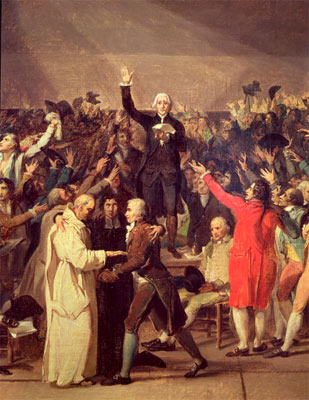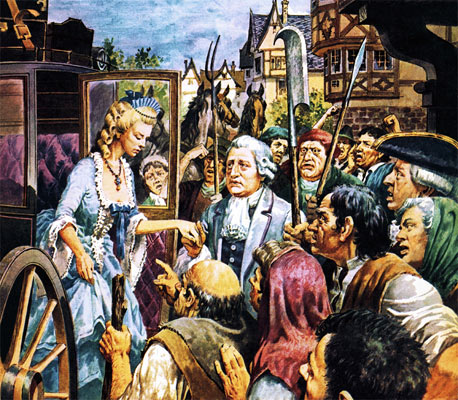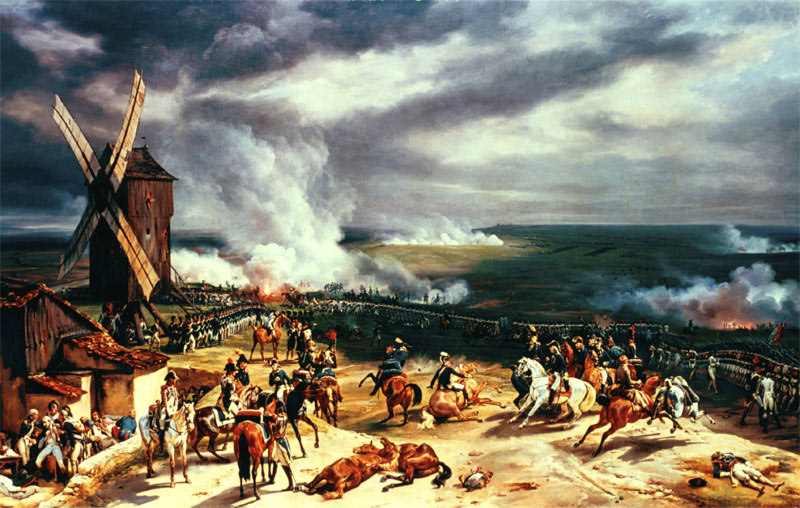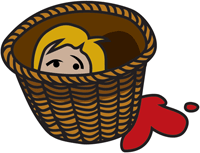< Introducing Paris
Revolution!

The historic Tennis Court Oath, as depicted by Jacques-Louis David
The French Revolution is one of the most important events in European history. So many people lost their heads to the guillotine that the streets literally ran with blood – Parisians even turned on their king and queen and chopped off their heads as well. In a tumultuous 26 years, France went from being an absolute monarchy to a republic, then to the seat of Napoleon’s empire, and finally returned to a monarchy, this time a constitutional one.
Anyone for tennis?
Louis XVI needed cash. In order to hike up already crippling taxes, he was forced to convene the long-neglected French parliament, the Estates-General. This was made up of three tiers: the clergy, the nobility and the so-called Third Estate, which represented ordinary people.
This was seen by commoners as an opportunity to be heard, and they compiled huge books of complaints, which were brought to Versailles to be discussed.
When the reforms demanded by the Third Estate were blocked, their delegates declared themselves a National Assembly and, locked out of the main meeting hall on the king’s orders, adjourned to a nearby indoor tennis court, the Jeu de Paume, where they swore the historic Tennis Court Oath not to disband until France had a proper constitution. A week later Louis backed down and a National Assembly was born.
Man the barricades!
As a Constitution began to take shape, in Paris the debates and grievances on the streets turned into demonstrations and riots, as rumours ran wild that the king was about to in send the army to close down the National Assembly.
To forestall this, on 14 July, a mob stormed the hated Bastille prison in the belief it was full of weapons (in fact, it held just seven prisoners). As the starving peasantry began to revolt in earnest, killing nobles and priests, the National Assembly quickly abolished the feudal system left over from the Middle Ages and proclaimed liberty and equality for all citizens.
Arguments about the new Constitution would go on for two years, with confrontations between different revolutionary factions.
Royals on the run
Many of the people were convinced the king and his supporters were still plotting to reverse the reforms. Parisians were starving and, in October, an angry crowd of women marched to Versailles to protest. They broke into the palace threatening to tear Louis and his queen, Marie Antoinette, to pieces.
The king was forced to sign the Declaration of the Rights of Man, and to return to Paris with his family, where they were held in the Tuileries Palace, as prisoners of the National Assembly. After almost two years in captivity, Louis, afraid for his family’s safety, made a fatal error. They fled the capital for a royalist stronghold in the northeast, only to be captured just short of their destination, at Varennes, and brought back to Paris. Until this point most people had supported the idea of a constitutional monarch, but now the king was labelled a traitor.

King Louis XVI and Marie Antoinette
Prussian roulette
The rest of Europe was out to crush the Revolution, so the revolutionaries, fearing invasion, took a gamble and declared war on Prussia and Austria, in April 1792. It wasn’t long before the enemy was almost at the gates of Paris. Louis, with his Austrian wife, was accused by the radicals of being a foreign stooge. A mob stormed the Tuileries and took the royal family to the medieval Temple prison. In September, in a riot of blood-letting, working-class Parisians went on the rampage, killing 1,200 prisoners before marching off to win the Battle of Valmy. Back home, a guillotine was erected in Place de la Concorde to deal with their internal enemies.
Everything changes
The Revolution wasn’t just against the monarchy but also the power of the Catholic church, which was abolished. Notre-Dame was used as a warehouse. It was out with the old Christian calendar too. Each day was now made up of ten hours, each 100 minutes long, and a week was ten days long. Three weeks made up a month, and the twelve months were given new names related to the weather in northern France. This quirky calendar never really caught on, however, largely because such a long week meant there was only one day off in every ten. Meanwhile a new metric system of weights and measures was adopted and is still in use today.
Heads will roll
The Revolution took a radical turn, led by a ferocious faction called the Jacobins. A Committee of Public Safety, led by Danton, Marat and Robespierre, instigated “the Great Terror”, in which 300,000 people were arrested and 20,000 executed in Paris alone. In January 1793, Louis XVI was taken to Place de la Concorde and guillotined in front of a huge crowd. In October Marie Antoinette followed her husband to the scaffold, jeered by ghoulish spectators. However, in July 1794 the Jacobins were overthrown by a more moderate faction, and Robespierre and his cronies were sent to the guillotine themselves.

The revolutionary army’s victory over Prussia at Valmy
A rising star
Revolutionary France faced enemies from within as well as abroad, and was ever more dependent on its armies. In 1795 a royalist revolt was put down by a young Corsican general, Napoleon Bonaparte, who dispersed the mob by firing into it with cannons at point-blank range.
Napoleon was soon a national hero. His military successes in Italy and Egypt conquered new territories for France. In 1799 he seized power in a military coup and installed himself as First Consul. By 1804 he had crowned himself Emperor of France, at Notre-Dame.
The end of an era
For many years, Napoleon’s power expanded across the continent. It was Russia that called a halt to his adventures, when his 1812 march towards Moscow went disastrously wrong. By 1814 the Russians, Prussians and British occupied Paris. Napoleon was exiled on the island of Elba but he soon returned, leading an army against the British at Waterloo. This was his final defeat, and he was again sent into exile on the island of St Helena, where he died in 1821.
Key dates
5 May 1789 The Estates-General convenes
20 June 1789 The Tennis Court Oath
14 July 1789 The storming of the Bastille begins the Revolution
26 August 1789 Declaration of the Rights of Man and the Citizen
6 October 1789 Versailles is stormed; Louis XVI and his family are returned to Paris as prisoners
21 June 1791 The royal family’s “Flight to Varennes“ is foiled
21 September 1792 The monarchy is formally abolished
1792–4 “The Terror“
21 January 1793 Louis XVI is found guilty of treason and executed
16 October 1793 Execution of Marie Antionette
28 July 1794 Robespierre is guillotined; end of the Terror
9 November 1799 Napoleon seizes power after putting down a Royalist revolt
Facts & figures
Off with his head!
Dr Guillotine, who introduced his razor-sharp namesake to France, thought he was doing everyone a favour. Until then only nobles had the right to a swift beheading. Now everyone was to be equal, and death would be efficient and painless.
Executions drew big crowds. All the family came along, and women even brought their knitting and sat in front of the scaffold as if they were watching TV.
Guess who advised Dr Guillotine on the development of his killing machine? No less than Louis XVI, who was an amateur locksmith.
False fact file
The one thing that everyone “knows” about Marie Antoinette, the hated wife of Louis XVI, is that, when the women of Paris stormed her palace at Versailles demanding bread to feed their starving families, she haughtily (or naïvely) dismissed them with the famous remark, “Let them eat cake.” In fact, it is a near-certainty that she never said this at all. Somebody made it up.
Vive La Revolution!
France’s National Day 14 July. Tanks trundle down the Champs-Elysees in a military parade, low-flying jet planes shoot across the sky, and there is a huge firework display in front of the Eiffel Tower. It marks the day the people of Paris stormed the Bastille prison and the Revolution began.






